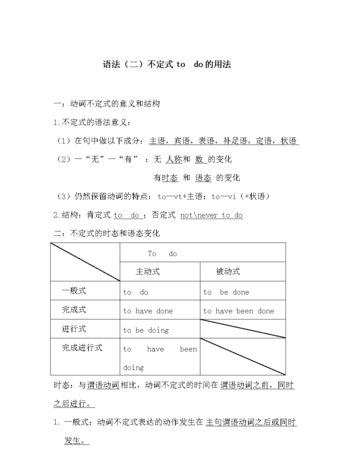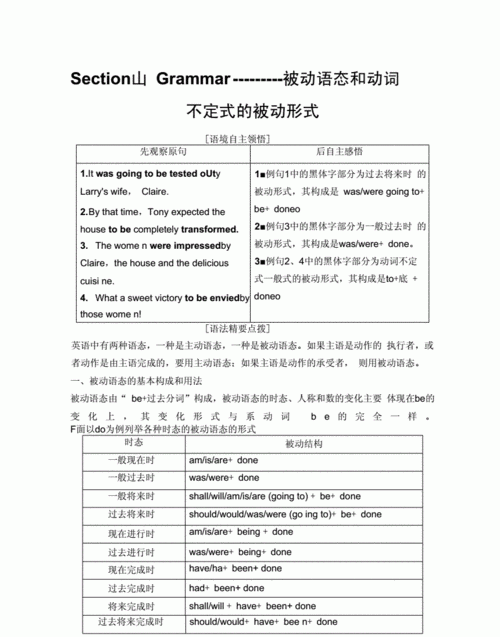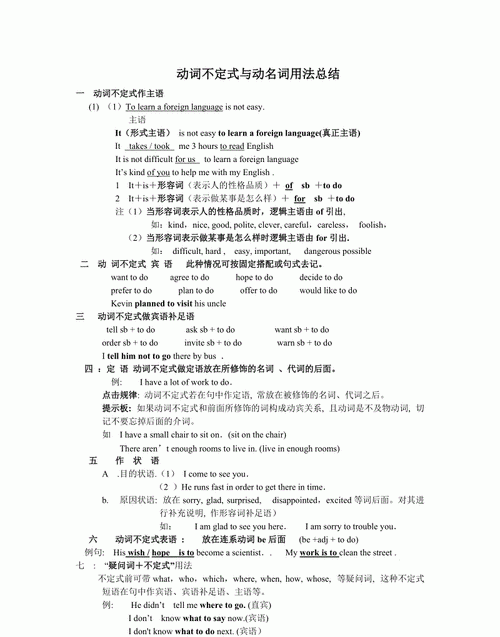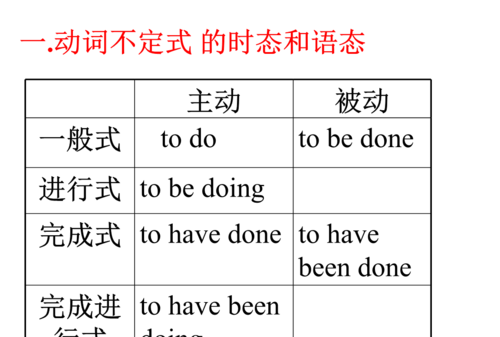本文目录
英语各大时态的英文表达
英语的16种时态
英语共有十六种时态,其表现形式如下(以study为例)
一般时 进行时 完成时 完成进行时
现在 study be studying have studied have been studying
过去 studied be studying had studied had been studying
将来 will study wil be studying will have studied will have been studying
过去将来would study would be studying would have studied would have been studying
时态(Tense)是表示行为、动作和状态在各种时间条件下的动词形式。因此,当我们说时态结构的时候,指的是相应时态下的动词形式。
1. 一般现在时
英语时态分为16种:一般现在、一般过去、一般将来、过去将来时,以及这四者的进行时、完成时和完成进行时。
用法:A) 表示现在发生的动作、情况、状态和特征。
B) 习惯用语。
C) 经常性、习惯性动作。
例:He always helps others. (他总是帮助别人。)
D) 客观事实和普遍真理。尤其要注意,如果前后文不是一般现在时,则无法保持 主句、从句时态一致。
E) 表示一个按规定、计划或安排要发生的动作,(仅限于某些表示“来、去、动 、停、开始、结束、继续”等的动词 )可以与表示未来时间的状语搭配使用 。常见的用法是:飞机、火车、轮船、汽车等定期定点运行的交通方式。
例:The next train leaves at 3 o'clock this afternoon.
(下一趟火车今天下午3点开车。)
How often does this shuttle bus run? (这班车多久一趟?)
F) 在时间和条件状语从句里经常用一般现在(有时也用现在完成时)表示将来事 情。
例:When you have finished the report, I will have waited for about 3 hours.(等你完成这份报告的时候,我就已经等了将近3个小时了。)
2. 现在进行时(be doing)
用法:现在正在进行的动作。
3. 现在完成时(have done)
用法:A) 表示动作到现在为止已经完成或刚刚完成。
例:I bought a new house, but I _________ my old one yet, so at the moment I have two houses.
A) didn't sell B) sold C) haven't sold D) would sell
答案是C) haven't sold。
B) 表示从过去某时刻开始,持续到现在的动作或情况,并且有可能会继续延续下去。此时经常用延续性动词。时间状语常用since加一个过去的时间点,或for加一段时间,或by加一个现在时间。
例:Great as Newton was, many of his ideas ___________ today and are being modified by the work of scientists of our time.
A) are to challenge C) have been challenged
B) may be challenged D) are challenging
全句的意思是:“虽然牛顿是个伟大的人物,但他的许多见解直到今天还在受到挑战,并且被现代科学家的工作所修正。”challenge是及物动词,在本句中应当是被动语态;其动作延续到今天,所以要用现在完成时态。可见答案是C) have been challenged。A) are to challenge和D) are challenging都是主动语态,不可能是答案。B) may be challenged虽然是被动语态,但意思与全句内容不合,所以不对。
C) 表示发生在过去,但对现在仍有影响的动作或情况。通常用点动词,如:arrive, begin, find, give, lose等。
例:John has broken his left leg.(约翰摔断了左腿。)
注意事项:A) 现在完成时是联系过去和现在的纽带。现在完成时和过去时的区别在于:现在完成时强调动作的动态,或受动态的影响,是动态的结果,对现在有影响;过去时只表示过去的某个具体时间里发生的动作,与现在没有联系。
例:He worked in that hospital for 8 years.(他曾经在那家医院工作了8年。这只是讲述一个过去的事实,他现在已经不在那家医院了。)
He has worked in that hospital for 8 years.(他已经在那家医院里工作了8年。表示他从过去开始工作,一直工作到现在,现在仍在那家医院工作。)
B) 因为含有for加一段时间或since加一个时间点这样的时间状语的完成时,有动态和延续性的特点,所以不能使用终端动词或瞬间动词。
例:My sister has been married for 5 years.(过去分词做表语表示状态,可以延续)
My sister has married. Don't disturb her.(终端动词)
C) 在"this is the first/ second/ third…… time that……"句型里要求用完成时。
例:This is the second time that the products of our company have been shown in the International Exhibition.(这是我公司产品第二次参加国际展览会。)
D) 句型"It is/ has been……since"所使用的两种时态都正确。
例:It is/ has been 10 years since I last saw him.(从我上次见到他以来已经10年了。)
E) 在"no sooner than"、"hardly/ scarcely ……when"、"before"、"prior to"等句型中,主句要求完成时。
例:I haven't met that professor prior to today.(以前我从未见过那位教授。)
4. 现在完成进行时(have been doing)
用法:表示某一动作开始于过去某一时间,延续或重复地出现至今,或将继续延续至将来。
例:We have been working on this project for over a month now.(到目前为止,我们一直在处理那个项目,已经花了一个多月时间了。)
注意事项:与现在完成时相比,现在完成进行时更强调:在从过去到现在的时间里,动作或状态一直持续或一直反复出现。
例:It seems oil ___________ from this pipe for some time. We'll have to take the machine apart to put it right.
A) had leaked B) is leaking
C) leaked D) has been leaking
从本题上下文看,这两个句子的意思是:“看来,这个管道漏油已有一段时间了,我们将不得不拆卸机器排除故障。”第二句表示将要采取的措施。第一句动作发生在第二句之前,并且延续到现在为止仍在继续。因此,空格中需用现在完成时或现在完成进行时。D) has been leaking是现在完成进行时,因此是本题的答案。有11%的考生误选了B) is leaking。由于本句有时间状语for some time,表示谓语动作延续,谓语不能用现在进行时,必须用和完成时有关的时态。有些考生误选了C) leaked或A) had leaked。是因为他们没有注意到本题第二句是一般将来时,所以第一句的谓语不能用过去时或过去完成时。
5. 一般过去时
用法:A) 表示过去某个时间发生的动作或情况。
B) 表示过去习惯性动作。特别是由would/ used to do表达的句型,本身表示的 就是过去时。
例:The old man would sit on a bench in the quiet park and look at others for hours without doing anything or talking to anybody.(老人过去常常坐在宁静的公园里的一条长椅上,看着其他的人,一坐就是数个小时,什么也不干,也不和任何人交谈。)
He used to visit his mother once a week.(他以前总是每周看望一次他的母亲。)
C) 有时可代替一般现在时,表达一种婉转、客气、礼貌、商量的语气。
例:I wanted to ask you if I could borrow your car?(我想向您借车用一用,可以吗?)
Would you mind my sitting here?(您介意我坐在这里吗?)
注意事项:A) 注意时间状语的搭配。一般过去时的时间状语应该是表示过去某个时间的词或词组,如:yesterday, last month, in 1999, two days ago等,绝对不可与recently, in the past 10 years, this month等连用,因为这样的时间状语都与现在有关系,应该用现在完成时或一般现在时。
B) used to do的否定形式和疑问形式很特别:你怎么写都正确。以否定形式为例:used not to do, didn't used to do, didn't use to do都对。
Used to do经常与 be used to doing sth/ sth结构进行对比。前者表示"过去常常或
过去曾经",要求加动词原形;后者表示"习惯于",要求加名词或动名词。
6. 过去完成时(had done)
用法:表示在过去的某个时间或动作以前已经发生的动作或已经存在的状态。就是我们常说的:表示"过去的过去的动作或状态"。
Until then, his family _________ from him for six months.
A) didn't hear C) hasn't heard B) hasn't been hearing D) hadn't heard
全句的意思是:“到那时为止,他家里已经有六个月没得到他的消息了。”由此可以看出,谓语动词的动作延续到过去的某一时刻才完成,因此谓语要用过去完成时。答案是D)。其它选项中:A) didn't hear,因为一般过去时只表示过去发生的事情或存在的状态,所以不能与时间状语for six months连用。B) hasn't been hearing,现在完成进行时表示过去某时刻继续到现在或现在还在进行的动作,与题意不符。C) hasn't heard,现在完成时表示从过去某一时刻到现在为止发生的动作。而题中的then只表示过去的某一时刻,不能表示现在时间。
注意事项:“过去的过去”这种逻辑关系常通过上下文体现出来,而不一定受某个时间状语的限制。
例:There had been some one in our room just now, because I noticed a burning cigarette end on the floor when we opened the front door.(刚才有人在我们的房间里,因为我们打开前门进来时,我注意到地板上有一支仍在燃烧的香烟。)
分析:虽然时间状语是just now,似乎应该使用一般过去时,但是“在房间里”这个状态是在"开门"和"注意"这两个过去的动作之前就存在的,所以应该用过去完成时。
7. 过去将来时(would/ should do)
用法:表示从过去的某个时间看将要发生的事。
例:I said on Thursday I should see my friend the next day.(我星期四说我将于第二天拜访我的朋友。)
注意事项:由于过去将来时是由过去时和将来时组合而成的,所以其注意事项可以参考过去时和将来时的相关注意事项。
8. 过去进行时(was/ were doing)
用法:A) 表示在过去一个比较具体的时间正在发生的动作。
例:Mary was listening to light music 10 minutes ago.(10分钟前,玛丽正在听轻音乐。)
B) 如果when, while这样的时间状语引导词所引导的主从句之一是一般过去时,则另一个句子常用过去进行时。
例:I was washing my hair when you knocked at the front door.(你敲前门时我正在洗头发。)。
注意事项:其它与将来时有关的事项请参见下面所讲的一般将来时
9. 一般将来时
用法:A) 基本结构是will / shall do。
例:We shall send her a glass hand-made craft as her birthday gift.(我们将送给她一个玻璃的手工制品,作为给她的生日礼物。)
B) 有些动词,如:arrive, be close, come, do, done, go, have, leave, open, play, return, sleep, start, stay等,用于一般进行时,并且通常与一个表示将来时间的时间状语连用,可以表示将来时。
例:My mother is coming to visit me next week and is staying here until May.(我妈妈下周将来看我,并会呆到5月。)
C) 表示“打算去……,要……”时,可用be going to do。
例:This is just what I am going to say.(这正是我想说的。)
D) 表示“即将、正要”时,可用be about to do。强调近期内或马上要做的事。
例:Don't worry, I am about to make a close examination on you.(别担心,我马上就给你做一次仔细的检查。)
E) "be to do"的5种用法:
a) 表示“按计划、安排即将发生某事或打算做某事”。
例:She is to be seen in the lab on Monday.(星期一你准会在实验室见到她。)
b) 该做或不该做的事情(语气上接近于should, must, ought to, have to),表示一种命令、规劝性语气。
例:You are to go to bed and keep quiet, kids. Our guests are arriving in less than 5 minutes.(孩子们,你们必须 上床睡觉,不准吵闹。我们的客人5分钟之内就要到了。)
c) 能或不能发生的事情(接近can, may)
例:How am I to pay such a debt?(我怎么可能还得起这么大的一笔债呢?)
d) 不可避免将要发生的事情,后来将要发生的事情。
例:I assure you that the matter _______ as quickly as possible. Have a little patience.
A. will be attended B. will be attended to
C. is attended D. is attended to
will be attended to关键的一点是:attend表示“处理,解决”时是不及物动词,必须与to连用。另外,从上下文看,事情显然尚未解决,所以应该用将来时的被动语态。答案是B。
e) 用于条件从句“如果……想,设想”(接近if ……want to,或if ……should)
例:Greater efforts to increase agricultural production must be made if food shortage ____________ avoided.
A) is to be B) can be C) will be D) has been
答案是A) is to be。全句的意思是:“如果要避免食品短缺,就必须作出更大努力来增加农业产量。”
F) 同样可以表示“正要、将要”的意思的句型是be on the point of doing。
例:The coach is on the point of giving up the game because our team has been scored 7 points.(教练想要放弃这场比赛了,因为对方已经射进了7个球。)
例:I was _______ the point of telephoning him when his letter arrived.
A) in B) to C) at D) on
答案是D)。on the point of doing 是固定词组,意思是“正要、打算”。全句的意思是:“当他的信到的时候我正要打电话给他。”
注意事项:
在以if, when, as long as, as soon as, after, before, in case, until, unless等连词以及具有连词作用的副词(immediately, the moment, directly)等引导的状语从句,一般用现在时代替将来时。强调延续性或动态时,可用完成时。
例:I hope his health will have improved by the time you come back next year.(我希望到明年你回来的时候,他的身体已经好多了。)
10. 将来进行时(will be doing)
用法:强调在将来的某个具体时间正在发生的动作或事情。
例:Don't worry, you won't miss her. She will be wearing a red T-shirt and a white skirt at that time.(别担心,你不会认不出她的。她到时会穿一件红色的T恤衫和一条白色的短裙。)
注意事项:由于本时态是由将来时和进行时融合在一起的,所以关于本时态的注意事项,可参考"一般将来时"和"现在进行时"的有关注意事项。
11. 将来完成时(will have done)
用法:表示从将来的某一时间开始、延续到另一个将来时间的动作或状态,或是发生在某个将来时间,但对其后的另一个将来时间有影响的动作或状态。就好象把现在完成时平移到时间轴的将来时时段一样。其用法从和过去及现在有关,变成了和将来及将来的将来有关。
例: The conference __________ a full week by the time it ends.
A) must have lasted B) will have lasted
C) would last D) has lasted
本题考核谓语动词的时态。全句的意思是:“会议从开始到结束将持续整整一个星期。”句中by the time it ends表示动作要延续到将来某一时刻,因此要用将来完成时。答案是B) will have lasted。如果选A),因为情态动词must后面接动词不定式的完成时形式表示对已经发生的事情的一种肯定推测,而本句的时间状语是by the time it ends而非by the time it ended,所以犯了时态不呼应的错误。Would虽可以表示推测或可能性,但would last不能表示延续到将来某一时刻的动作,所以C) would last错误。因为D) has lasted是现在完成时,表示到现在为止已经完成的动作,不能表示延续到将来某一时刻的动作,所以也不正确。
注意事项:由于本时态是由将来时和完成时融合在一起的,所以关于本时态的注意事项,可以参考“一般将来时”和“现在完成时”的有关注意事项。
12)将来完成进行时:shall have been doing ,will have been doing
例:By the end of next month, the project will have been being worked for 3 years. (到下个月底为止,这项工程就已经不停地进行了3年了。)(被动语态)
13)过去完成进行时:had been doing
例:The old clock had been being taken apart of and fixed up again for several times by my 10-year old son before I came back home.(我回到家之前,我10岁大的儿子已经把这个旧钟表拆卸并重新组装了好几回了。)(此处强调“拆卸”和“组装”这两个过去的过去的动作一直在反复进行。)(被动语态)
14) 过去将来进行时:should be doing , would be doing
例:The government promised that a new highway would be being built next July.(政府承诺说第二年7月将有一条新的高速公路正在修建。)(此句的时间状语是具体的将来时间,所以最好用将来进行时。)(此句为被动语态)
15) 过去将来完成时:should have done , would have done
例:I believed by the end of that year an advanced version of that software would have been developed, but I was wrong.(我坚信到那年年底为止,那个软件的新版本将被开发出来。但是我错了。)(此句为被动语态)
16) 过去将来完成进行时:should have been doing , would have been doing
例:They said that by the end of the following month, the project would have been being worked for 3 years. (他们说到第二个月底为止,这项工程就已经不停地进行了3年了。)

非谓语动词怎么判断用不定式还是动名词
1) 动词+ 不定式
afford. aim. appear. agree. arrange . ask . be . decide. bother . care . choose . come. dare. demand. desire. determine . expect. elect . endeavor .hope. fail . happen . help . hesitate .learn . long . mean. manage . offer . ought. plan . prepare. pretend . promise. refuse. seem. tend. wait . wish. undertake.
举例:
The driver failed to see the other car in time.
司机没能及时看见另一辆车。
I happen to know the answer to your question.
我碰巧知道你那道问题的答案。
2)动词+不定式 ;动词+宾语+不定式
ask, beg, choose, expect , hate, help intend like, love, need prefer, prepare, promise, want, wish…
I like to keep everything tidy. 我喜欢每件东西都保持整洁。
I like you to keep everything tidy. 我喜欢你使每件东西都保持整洁。
I want to speak to Tom. 我想和汤姆谈话。
I want you to speak to Tom. 我想让你和汤姆谈话。
3) 动词+疑问词+ to
decide, know, consider forget, learn, remember, show, understand, see, wonder, hear, find out, explain, tell
Please show us how to do that. 请演示给我们如何去做。
There are so many kinds of tape-recorders on sale that I can't make up my mind which to buy.有这么多的录音机,我都拿不定主意买哪一种。
注意:疑问词带不定式在句中作成分时,谓语动词用单数。
The question is how to put it into practice.
问题是怎样把它付诸实施。
4)以下动词后,只能跟不定式作宾语。
如:agree,ask,aim,arrange,choose,decide,demand,expect,fail ,help,hope,lean,long,manage,offer,plan,prepare,
pretend,promise,refuse,wish 等,这些词大部分可接th at引导的从句。如:
I decided to ask for my money back.
I decided that I would ask for my money back.
When our visit to the farm was over,we expected to startback on foot.
When our visit to the farm was over, we expected that wewould start back on foot.
5)当复合宾语中的宾语是不定式时,先用形式宾语it代替不定式,把不定式置于补语之后,即:主语+动 词+it+补语+to do句式。如:
We think it quite important for us to learn a foreignlanguage well.
He feels it his duty to help the poor.
二、作补语
1) 动词+宾语+不定式(to do)
advise allow appoint believe cause challenge command compel consider declare drive enable encourage find forbid force guess hire imagine impel induce inform instruct invite judge know like order permit persuade remind report request require select send state suppose tell think train trust understand urge warn
例句:
a. Father will not allow us to play on the street.
父亲不让我们在街上玩耍。
b. We believe him to be guilty.
我们相信他是有罪的。
Find 的特殊用法:
Find 后可用分词做宾补,或先加形式宾语,再加形容词,最后加带to 的动词不定式。find后也可带一个从句。此类动词还有get,have。
I found him lying on the ground.
I found it important to learn.
I found that to learn English is important.
2) to + be 的不定式结构,作补语的动词。
Acknowledge, believe, consider, think, declare(声称), discover, fancy(设想), feel find, guess, judge, imagine, know, prove, see(理解), show, suppose, take(以为), understand
We consider Tom to be one of the best students in our class.
我们认为汤姆是班上最好的学生之一。
3) to be +形容词
Seem, appear, be said, be supposed, be believed, be thought, be known, be reported, hope, wish, desire, want, plan, expect, mean…
The book is believed to be uninteresting.
人们认为这本书没什么意思。
4) there be+不定式
believe, expect, intend, like, love, mean, prefer, want, wish, undrstand
We didn't expect there to be so many people there.我们没料到会有那么多人在哪里。
有些动词需用as 短语做补语,如regard, think believe, take, consider.
We regard Tom as our best teacher. 我们认为汤姆是我们最好的老师。
Mary took him as her father . 玛丽把他当作自己的父亲。
三、作主语
动词不定式作主语时,句子的谓语动词常用单数,其位置有以下两种:
(1)把不定式置于句首。如:
To get there by bike will take us half an hour.
(2)用it作形式主语,把真正的主语不定式置于句后,常用于下列句式中。如:
①It+be+名词+to do
It's our duty to take good care of the old.
②It takes sb+some time+to do
How long did it take you to finish the work?
③It+be+形容词+for sb+to do
It is difficult for us to finish writing the compositionin a quarter of an hour.
④It+be+形容词+of sb+to do
It is stupid of you to write down everything the teachersays.
⑤It seems(appears)+形容词+to do
It seemed impossible to save money.
在句型③中,常用表示客观情况的形容词,如:difficult,easy,hard,important,impossible,necessary 等;在句型④中,常用careless,clever,good,foolish,honest,kind,lazy,nice,right,silly,stupid,wise等 表示赞扬或批评的词。在不定式前的sb,可看作其逻辑主语。这一句式有时相当于Sb is+形容词+to do句式 ,如:It'skind of you to help me with my English.=You are kind to helpme with my English.
(3)举例
1) It's easy (for me) to do that.我做这事太容易了
easy, difficult, hard, important, possible, impossible, comfortable, necessary, better;
the first, the next, the last, the best, too much, too little, not enough
It's so nice to hear your voice.
听到你的声音真高兴。
It's necessary for you to lock the car when you do not use it.
当你不用车的时候,锁车是有必要的。
2) It's very kind of you to help us. 他帮助我们,他真好。
Kind, nice, stupid, rude, clever, foolish, thoughtful, thoughtless, brave, considerate(考虑周到的), silly, selfish(自私的)
例句:
It was silly of us to believe him. 我们真愚蠢,竟然相信了他。
It seemed selfish of him not to give them anything. 他不给他们任何东西,这显得太自私了。
注意:1) 其他系动词如,look,appear等也可用于此句型
2) 不定式作为句子成分时,动词用单数形式。
3) 当不定式作主语的句子中又有一个不定式作表语时,不能用It is… to…的句型
(对)To see is to believe. 百闻不如一见。
(错)It is to believe to see.
四、作表语
不定式作表语表示具体动作或将来动作;动名词作表语表示抽象的一般行为。
①To be kind to the enemy is to be cruel to the people.
②My chief purpose is to point out the difficulties ofthe matter.
③What I would suggest is to put off the meeting.
当主语和表语都是不定式时,其含义一是条件,一是结果(例①)。当主语是aim,duty,hope,idea,mista ke,plan,purpose,suggestion等为中心词的名词词组(例②)时,或以what引导的名词性分句(例③),不定 式说明主语的内容。
④Our work is serving the people.
⑤What he likes is taking a walk after supper.
⑥The story told by Mr.Wang is interesting.
④⑤句动名词作表语,与主语部分可以转换,如Serving thepeople is our work,而⑥句中是现在分词作 表语,说明主语的性质、状态,现在分词具有形容词的各种特征,另外,动名词作表语还应与进行时态区别开 来。
五、作定语
⒈不定式作定语
不定式在句中作定语,置于被修饰的名词或代词之后。如:
①The next train to arrive is from Washington.
②Have you anything to be taken to your sister?
③Do you have anything to say on the question?
④Would you please give me some paper to write on?
⑤My wish to visit France has come true at last.
不定式短语作定语和被修饰词之间表示以下关系:
(1)表示将来的动作(例①)。
(2)与被修饰词之间有动宾关系,如是不及物动词,则需加介词(例④)。
(3)与被修饰词之间有动宾关系,同时与句中其它词之间又有逻辑上的主谓关系时,尽管有被动含义,却仍 用主动语态(例③);如只有动宾关系,而无逻辑上的主谓关系,则需用被动语态(例②)。
(4)不定式作定语时,一般可转换为定语从句,例①to arrive=that will arrive。
六、作状语
1)目的状语
To… only to (仅仅为了), in order to, so as to, so(such)… as to… (如此……以便……)
He ran so fast as to catch the first bus. 他飞快地跑以便赶上第一班车。
I come here only to say good-bye to you. 我来仅仅是向你告别。
2)作结果状语,表事先没有预料到的,要放在句子后面。
What have I said to make you angry.
He searched the room only to find nothing.
3) 表原因
I'm glad to see you.
省to 的动词不定式
1) 情态动词 ( 除ought 外,ought to):
2) 使役动词 let, have, make:
3) 感官动词 see, watch, look at, notice , observe, hear, listen to, smell, feel, find 等后作宾补,省略to。
注意:在被动语态中则to 不能省掉。
I saw him dance.
=He was seen to dance.
The boss made them work the whole night.
=They were made to work the whole night.
4) 表示个人意愿或倾向的would rather,had better,might(just) as well:rather than置于句首时。
Rather than ride on a crowded bus,he always prefers to ride a bike.
5) Why… / why not…:
6) help 可带to,也可不带to, help sb (to) do sth:
7) but和except:but前是动词do时,后面出现的动词用不带to的动词不定式。
8) 由and, or和than连接的两个不定式,第二个to 可以省去:
9) 通常在discover, imagine, suppose, think, understand等词后,可以省去to be:
He is supposed (to be) nice. 他应该是个好人。
10)but作介词,后接不定式结构时,前面谓语动词部分若含有do的形式时,but后的不定式要省去to,否则要带to。
He wants to do nothing but go out.
He wants to believe anything but to take the medicine.
11)当两个或多个不定时短语由连词and,but或or连接时,后一个或几个不定式符号to常省略。但若表示对比、对照关系时,则不能省略。
He wants to move to France and marry the girl.
The purpose of new technologies is to make life easier,not to make it more difficult.
12)不定式做表语时,一般要带to,但若主语部分中含有do的各种形式时,符号to可省去。
We've missed the last bus.All we could do now is walk home.
动词不定式的否定式
Tell him not to shut the window…
She pretended not to see me when I passed by. 我走过的时候,她假装没看见。
不定式的特殊句型
1、不定式的特殊句型so as to
1) 表示目的;它的否定式是so as not to do。
Tom kept quiet about the accident so as not to lose his job.
汤姆对事故保持沉默是为了不丢掉他的工作。
Go in quietly so as not to wake the baby.
轻点进去,别惊醒了婴儿。
2) so kind as to ---劳驾
Would you be so kind as to tell me the time?
劳驾,现在几点了。
2、 "Why not +动词原形"表达向某人提出建议
"为什么不……?" "干吗不……?"
例如:
Why not take a holiday?
干吗不去度假?
3、It's for sb.和 It's of sb.
1)for sb. 常用于表示事物的特征特点,表示客观形式的形容词,如easy, hard, difficult, interesting, impossible等:
It's very hard for him to study two languages. 对他来说学两门外语是很难的。
2)of sb的句型一般用表示人物的性格,品德,表示主观感情或态度的形容词,如good, kind, nice, clever, foolish, right。
It's very nice of you to help me. 你来帮助我,你真是太好了。
for 与of 的辨别方法:
用介词后面的代词作主语,用介词前边的形容词作表语,造个句子。如果道理上通顺用of,不通则用for。如:
You are nice. (通顺,所以应用of)。
He is hard. (人是困难的,不通,因此应用for。)
4、不定式的特殊句型too…to…
1)too…to 太…以至于…
He is too excited to speak.
他太激动了,说不出话来。
---- Can I help you ? 需要我帮忙吗?
---- Well, I'm afraid the box is too heavy for you to carry it, but thank you all the same. 不用了。这箱子太重,恐怕你搬不动。谢谢您。
2) 如在too前有否定词,则整个句子用否定词表达肯定, too 后那个词表达一种委婉含义,意 为"不太"。
It's never too late to mend. (谚语)
改过不嫌晚。
3) 当too 前面有only, all, but时,意思是:非常… 等于very。
I'm only too pleased to be able to help you. 我非常高兴能帮助你。
He was but too eager to get home. 他非常想回家。动词不定式的"to"与介词的"to"区别 to 有两种用法:
一为不定式+动词原形;
一为介词+名词/动名词, to 在下面的用法中是第二种,即to+ 名词/动名词:
admit to承认,confess to承认,be accustomed to 习惯于,be used to 习惯于, stick to 坚持, turn to开始,着手于, devote oneself to 献身于, be devoted to 致力于, look forward to 盼望,pay attention to 注意
介词but,except,besides+to do(do)
在这种句型中,如介词前有动词do,后面应接不带to的不定式;如无do,则接to不定式,即带do不带to, 带to不带do。如:
The enemy soldiers had no choice but to give in.
On Sunday afternoon I had nothing to do but watch TV.
动词不定式与动名词区别与联系
1) 动名词与不定式的区别:
动名词表达的是: 状态,性质,心境,抽象,经常性,已发生的 不定式表达的是: 目的,结果,原因,具体,一次性,将发生的
2) 接不定式或动名词,意义相同。
3)在下列情况下,一般要用不定式:
①hate,like,love前有would(should)时,如:I'd like to have a cup of coffee.
②当谓语动词begin,continue,start等是进行式时,如:Thestudents are starting to work on the di fficult maths problem.
③begin,continue,start与know,understand等状态动词连用时,如:I soon began to understand what was happening.
⒋advise,allow,encourage,forbid,permit等动词后接动名词作宾语,或带不定式作宾语补足语。如:
Our teachers don't permit our/us swimming in the lake.
Our teachers don't permit us to swim in the lake.
4) 部分动词后接不定式或动名词时,意义差别较大,应根据句子语境选择使用。
①forget,remember,regret后接不定式,表示现在或未来的动作,接动名词表示动作已经发生。如:
Don't forget fo post the letter for me.
Have you forgotten meeting her in Beijing Airport?
Remember to close the windows before you leave.
I remember writing him a letter a year ago.
We regret to tell you that all of you are not invited toattend the meeting.
They regretted ordering these books from abroad.
动名词与不定式语义不同的有11 组:
1 stop to do stop doing
2 forget to do forget doing
3 remember to do remember doing
4 regret to do regret doing
5 cease to do cease doing
6 try to do try doing
7 go on to do go on doing
8 afraid to do afraid doing
9 interested to do interested doing
10 mean to do mean doing
11 begin/ start to do begin/ start doing
1 forget doing/to do
forget to do 忘记要去做某事。 (未做)
forget doing 忘记做过某事。 (已做)
The light in the office is stil on. He forgot to turn it off.
办公室的灯还在亮着,它忘记关了。(没有做关灯的动作)
He forgot turning the light off.
他忘记他已经关了灯了。 ( 已做过关灯的动作)
Don't forget to come tomorrow.
别忘了明天来。 (to come动作未做)
2 stop doing/to do
stop to do 停止,中断做某事后去做另一件事。
stop doing 停止做某事。
They stop to smoke a cigarette. 他们停下来,抽了根烟。
I must stop smoking.. 我必须戒烟了。
3 remember doing/to do
remember to do 记得去做某事 (未做)
remember doing 记得做过某事 (已做)
Remember to go to the post office after school.
记着放学后去趟邮局。
Don't you remember seeing the man before?
你不记得以前见过那个人吗?
4 regret doing/to do
regret to do 对要做的事遗憾。 (未做)
regret doing 对做过的事遗憾、后悔。 (已做)
I regret to have to do this, but I have no choice.
我很遗憾必须这样去做,我实在没有办法。
I don't regret telling her what I thought.
我不为告诉她我的想法而后悔。
5 cease doing/to do
cease to do 长时间,甚至永远停做某事。
cease doing 短时停止做某事,以后还会接着做。
That department has ceased to exist forever.
那个部门已不复存在。
The girls ceased chatting for a moment when their teacher passed by.
姑娘们在老师走过时,停了会聊天。
6 try doing/to do
try to do 努力,企图做某事。
try doing 试验,试着做某事。
You must try to be more careful.
你可要多加小心。
I tried gardening but didn't succeed.
我试着种果木花卉,但未成功。
7 go on doing/to do
go on to do 做了一件事后,接着做另一件事。
go on doing 继续做原来做的事。
After he had finished his maths,he went on to do his physics.
做完数学后,他接着去做物理。
Go on doing the other exercise after you have finished this one.
作完这个练习后,接着做其他的练习
8 be afraid doing/to do
be afraid to do 不敢,胆怯去做某事,是主观上的原因不去做,意为"怕";
be afraid of doing 担心出现doing的状况、结果。 doing 是客观上造成的,意为"生怕,恐怕"。
She was afraid to step further in grass because she was afraid of being
bitten by a snake.
她生怕被蛇咬着,而不敢在草丛中再走一步。
She was afraid to wake her husband.
她不敢去叫醒她丈夫。
She was afraid of waking her husband.
她生怕吵醒她丈夫。
.9 be interested doing/to do
interested to do 对做某事感兴趣,想了解某事。
interested in doing 对某种想法感兴趣,doing 通常为想法。
I shall be interested to know what happens.
我很想知道发生了什么事。 (想了解)
I'm interested in working in Switzerland. Do you have any idea about that?
我对在瑞士工作感兴趣。你想过这事吗? (一种想法)
10 mean to doing/to do
mean to do 打算、想
mean doing 意味着
I mean to go, but my father would not allow me to.
我想去,但是我父亲不肯让我去。
To raise wage means increasing purchasing power.
赠加工资意味着增加购买力。
11 begin(start) doing/to do
begin / start to do sth
begin / start doing sth.
1) 谈及一项长期活动或开始一种习惯时,使用doing.
How old were you when you first started playing the piano?
你几岁时开始弹钢琴?
2) begin, start用进行时时,后面动词用不定式to do
I was beginning to get angry。
我开始生起气来。
3) 在attempt, intend, begin, start 后接know, understand, realize这类动词时,常用不定式to
do。
I begin to understand the truth。
我开始明白真相。
4) 物作主语时
It began to melt.

反身代词是物主代词吗
反身代词也叫自身代词。要想掌握反身代词其实并不难。下面将反身代词的构成和用法介绍给大家。
一、 反身动代词的构成:
第一、 第二人称的反身代词由形容词的物主代词加上self, selves构成。如:myself我自己 , ourselves我们自己 ,yourself你自己, yourselves你们自己.第三人称的反身代词是由宾格加上self, selves构成。如:himself他自己, herself她自己, itself它自己 ,以及themselves他们/她们/它们自己。值得注意的是,凡是单数人称代词的反身代词在后加self,而复数人称的反身代词在后加selves。
用来表示某人或某物属于\"谁的\"的代词叫做物主代词。 形容词性物主代词有:my(我的),your(你的、你们的),our(我们的),his(他的),her(她的),its(它的),their(他们的)。 形容词性物主代词具有形容词的特性,常放在名词前面作定语,表明该名词所表示的人或物是\"谁的\
动词不定式用法解读动词不定式是一种活跃的非谓语动词。它在句中起的是名词。形容词或副词的作用,可在句子中作主语。宾语。定语。状语和宾语补足语。动词不定式的形式是#to +动词原形#,但to有时要省去。动词不定式在具体运用时,用不用to,取决于谓语动词的用法:
一。带to的不定式结构
1.我们学过的能直接跟带to的不定式结构的动词主要有:want, ask, tell, hope, learn, try, decide, forget, remember, like ,love, stop, go, come等。
2.动词不定式的否定形式是在不定式前直接加not,即not to do sth.。例如:
Jim told me not to wake up Kate.吉姆告诉我别叫醒凯特。
二。不带to的不定式结构
下几种情况使用不带to的动词不定式:
1.在固定词组had better之后。注意:had better的否定形式是had better not do sth.。例如:
You had better go home now.你最好现在回家。
It]s cold outside. You]d better not go out.外面很冷,你最好不要出去。
2.在let,make,see, feel, watch,hear等感官或使役动词后,要跟不带to的动词不定式作宾语补足语。例如:
I made them give me the money back.我迫使他们把钱还给我。
I didn]t see you come in.我没看见你进来。
介词(preposition):也叫前置词。在英语里,它的搭配能力最强。但不能单独做句子成分需和名词或代词(或相当于名词的其他词类、短语及从句)构成介词短语,才能在句中充当成分。
介词的种类:
(1)简单介词:about, across, after, against, among, around, at, before, behind, below, beside, but, by, down, during, for, from, in, of, on, over, near, round, since, to, under, up, with等等。
(2)合成介词:inside, into, outside, throughout, upon, without, within
(3)短语介词:according to, along with, apart from, because of, in front of, in spite of, instead of, owing to, up to, with reguard to
(4)分词介词:considering, reguarding, including, concerning

动词不定式作宾语
以不定式结构为宾语的动词有:
ask, agree, care, choose, demand, decide, expect, fail, help, hope, learn, manage, offer, plan, prepare, pretend, promise, refuse, want, wish等只能用动词不定式作宾语
口诀(接不定式作宾语的动词)
想要学习 早打算( want learn plan)
快准备 有希望( prepare hope wish expect)
同意否 供选择(agree offer choose)
决定了 已答应(decide be determined promise)
尽力去 着手做(manage undertake)
别拒绝 别假装(refuse pretend)
失败不是属于你(fail)
e.g.Tom refused to lend me his pen.
We hope to get there before dark.
The girl decided to do it herself.
*注意:某些及物动词可用-ing也可用动词不定式作宾语但意义不同的有
stop go on remember forget
regret try mean can’t help
be used to

以上就是关于不定式的列表 ,英语各大时态的英文表达的全部内容,以及不定式的列表 的相关内容,希望能够帮到您。
